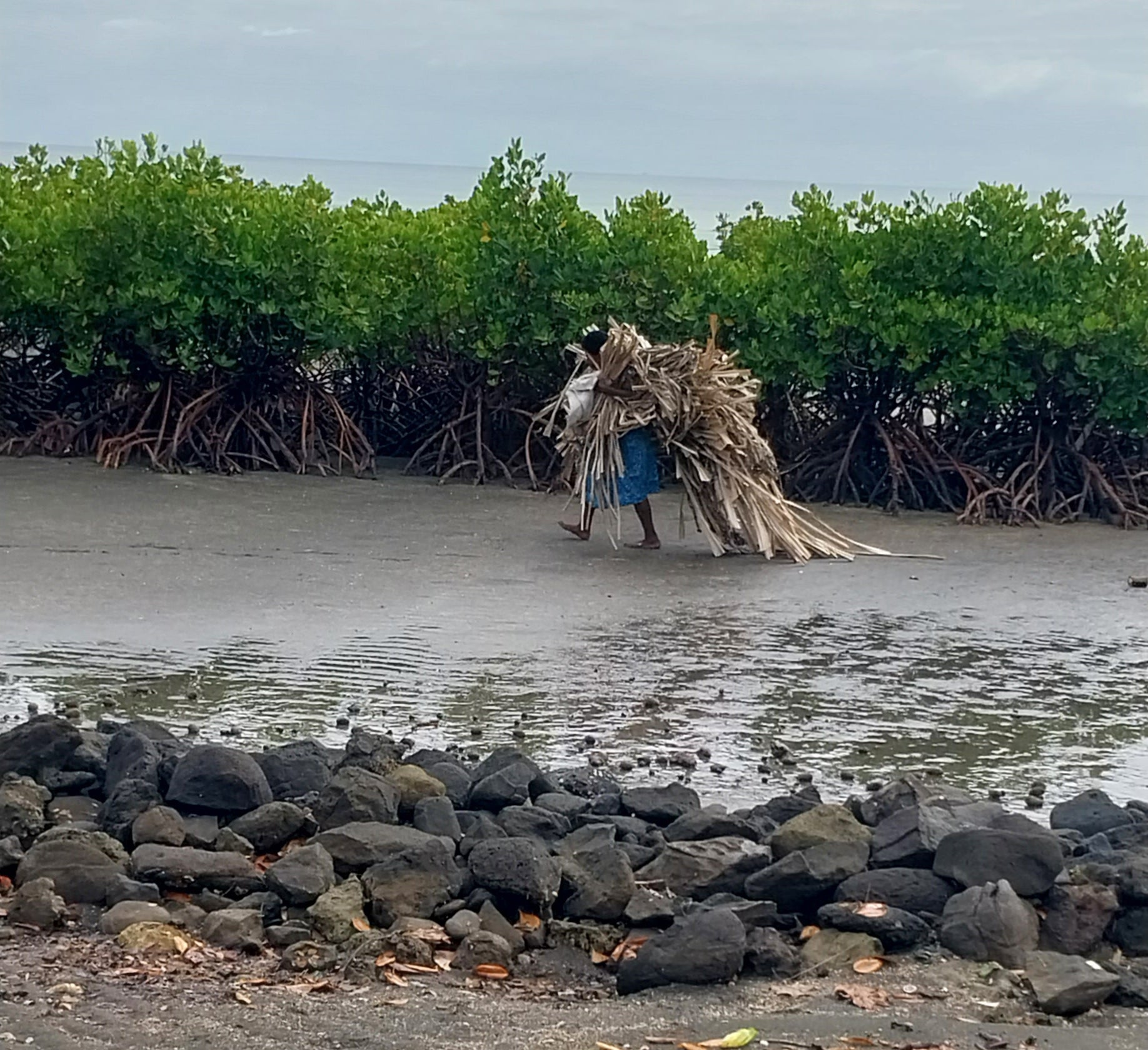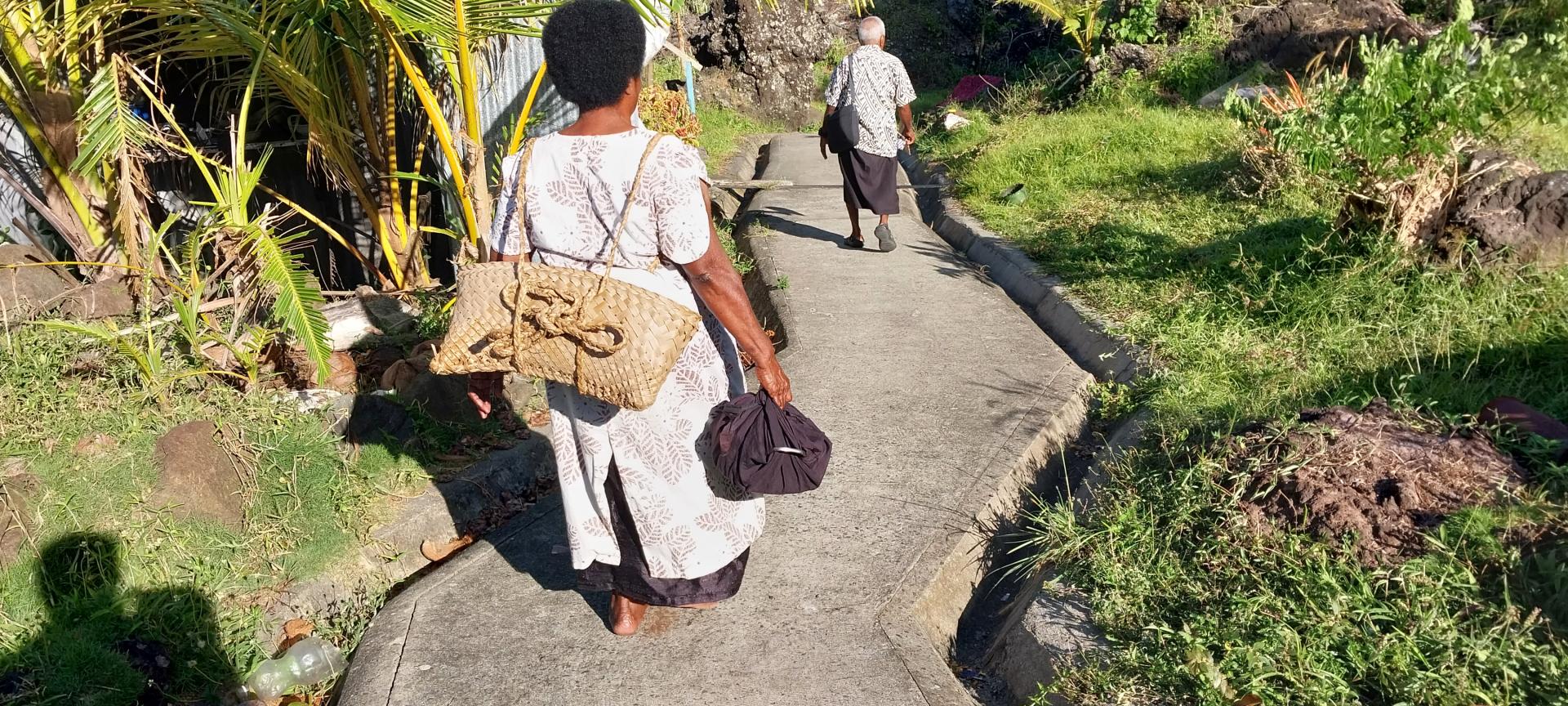
It’s 6:30 in the morning and dawn is just breaking. As the sun rises steadily over the horizon, I can hear the dragging of leaves on the sand, slow and consistent. I look at our hosts and they whisper, “It’s Bu Bau, she is back from the caves.” I run out to see Bu Bau, a 68-year-old woman cutting a lonely figure on the deserted beach, bent over from the weight of the pandanus leaves that she carries. Her barefoot strides are short, slow but steady, with a walking stick to aid her. Bu Bau, as she is fondly known, is one of the thousands of women from Fiji who still relies on and carries forward Traditional Knowledge and conservation methods.
Fiji is located in the South Pacific, and on one of the coasts of Fiji’s largest island is Nasau. Nasau is one of only three of the 91 villages in the province of Ra that can only be accessed by boat. Nasau is tucked away in the foothills of the Leuleu mountain range, which, loosely translated, means The Horns. To cut a road to Nasau would mean cutting through the mountain and subsequently destroying the forest and its vibrant ecosystem that the villagers depend on. The villagers have chosen to keep this region intact for as long as they possibly can, so as not to destroy the vegetation and their livelihood. Nasau is a name that means mana (work, succeed, make effective), and this is a village that is still rich in tradition and culture, strengthening and protecting our Traditional Knowledge.

Bu Bau carries her pandanus leaves over water.
The cave that Bu Bau just returned from is one that has been used not only by the people of Nasau, but also the
villagers from the neighboring communities for the sunning of pandanus leaves, which are woven for mats and other
handicrafts. Called the Qara ni Sigani Voivoi, or Cave for Sunning Pandanus Leaves, the cave is about 30–40 meters
long and 10 meters high. The Qara ni Sigani Voivoi is used during a specific time of year, from June to September.
This is when the sun has the most effect on the surface of the caves.
At other times of year, the women have to boil the pandanus leaves for at least half a day and dry them out in the sun on a daily basis, taking the time to turn the leaves at regular intervals. It is a tedious task that must be done well and consistently for weeks on end to ensure that the pandanus leaves are evenly sunned so they become the desired color. With the use of the cave, the women do not have to do these tedious tasks; they simply take their leaves and put them in the sun, using a stone to weigh them down. There is no boiling, constant turning, or worry that the leaves might get wet. The sunning of the leaves takes between two to three weeks.
Neighboring villages travel by horseback during low tide, walk along the shoreline, or hire boats to request per-
mission to utilize these caves for pandanus leaf sunning. This is an age-old tradition that has stood the test of time,
passed down from mother to child, woman to woman. When we asked Bu Bau whether she would prefer a dryer
to be built in the village, as it would be convenient, she responded with a resounding ‘No.’ “No. I don’t think it
would be good for me or the village,” she said. “True, it will be easier, but it will cause chaos and too much rubbish. Also, if it goes bad, we return to the caves, so better off without it. This is free, no trouble,” she explained.

Traditional handwoven bags.
While she might not realize it, Bu Bau has just described the cave as a method of conservation by way of keeping the environment safe. In her explanation and stand to not encourage installation of a dryer, Bu Bau protects and conserves the environment. The protection of Traditional Knowledge and stewardship of the environment is evident and strong in this village. For example, the villagers still use a waterfall as a form of natural massage. It is said that when the villagers are tired from planting and need a massage, they go to the falls. At the point where the water falls, there is a stone, worn through time, that one lies on and the water massages your back. It is protection of Traditional Knowledge like this that has made it possible for the villagers to approve more conservation projects on their custodian land, and to appreciate the necessity of preserving the land left to them by their ancestors in order for it to be used responsibly.
Since 2007, the villagers have dedicated one of their islands, Vatu I Ra, to become a bird sanctuary; the island is now known as the Vatu I Ra Park. This conservation effort was implemented collectively by Wildlife Conservation Society, Ra Provincial Council, Traditional leaders in Ra, Ra provincial government officers, and other civil society partners. The park is managed by the villagers in partnership with Birdlife International, and local residents have access to the resources on the island. The island is home to numerous breeding seabirds, earning its nickname “Bird Island.” It is the permanent home of nine species of seabirds, including red-footed and brown boobies, black noddies, lesser frigatebirds, and several species of tern.
The surrounding sea is a diverse ecosystem that is home to turtles, whales, dolphins, and over a hundred species of fish. Fishing is not permitted in the waters surrounding the Vatu I Ra Conservation Park and the villagers have a boat specifically to patrol against illegal fishing, but even still it remains a huge problem. Trespassing is another major problem in the management of the protected areas. Since the island is a sanctuary for birds, permission is needed
from the land owners before anyone can set foot on the island. Farmers, who are not land owners, frequently trespass on the island and harvest the birds’ excrement without permission, using it for fertilizer and selling the fertilizer without paying a commission to the land owners. The land owners continue to patrol their waters and continue to hold thieves and poachers accountable, however small the theft may be.
When a Fijian introduces themself, they can choose to tell you of their totem, which consists of the animal, the fruit, the plant, and the trees that they are identified within their province. This is why the Indigenous Fijian will always be connected to the land. In Fiji, we are often told that when we are born, we are born to a mataqali, or clan. The clan is given a kanakanaka (feeding ground) where we can plant and hunt. We are also given a qoliqoli, or fishing ground.
It is for this reason that Fijians are also reminded that we are just the custodians of the land. Fijians are taught from a young age that the land is communal and is shared not just by the present inhabitants, but is to be protected for the
future generations that are yet to enjoy the gifts of their forebearers.
--Ratu Emori Ganilau is Senior Community Engagement Officer at the Locally Managed Marine Areas Network. Isikeli Kainaigani is a marine biologist and holds the traditional position of Gone Dau, or official fisherman of the chief. Aliti Verevou Najoritani is a writer with roots in mainstream media and a passionate conservationist. The Locally Managed Marine Areas Network is a grassroots network dedicated to advancing locally-led natural resource management. It equips the resource owner with the knowledge to make sustainable decisions regarding their resources.
Top: Bu Bau (left) imparts knowledge to younger women.
